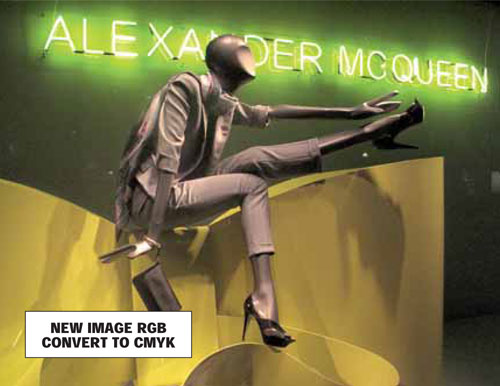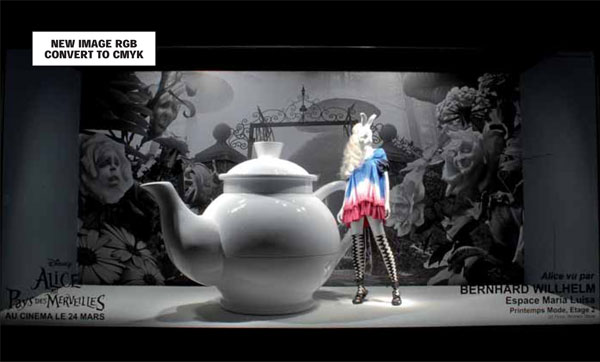Store study: Printemps

A window to promote the late British designer Alexander McQueen: a strikingly posed mannequin seated on a sculpted bow is all that is needed.
Printemps has been a pillar of the Parisian shopping culture since 1865, when Jules Jaluzot created the world-famous store that is still an important part of the Right Bank’s architectural heritage. The word printemps means “springtime.” Today, the once-exclusive French store has a presence in cities ranging from Tokyo to Jeddah. Its window displays are appreciated around the world for their quirky concepts and attention to detail, but its innovative ideas remain true to the original French brand that still makes Printemps a world-renowned destination store.
Franck Banchet, Printemps’ Creative Director, graduated from the CTE, a private school specializing in visual merchandising. After this excellent training he went on to manage the fashion floors at Printemps’ rival, Le Bon Marché, eventually moving to Printemps. Today, after ten years at Printemps, he instigates the creative concepts not only for the windows but also the vast interiors of 17 department stores.
Which of the windows that you have designed is your favorite?
“To visualize a window is to offer an interpretation, a vision of a certain world or a theme. I love working with artists or designers to construct a story together. Our visions blend and we produce something very strong. One of the installations that made an impression on me were the windows we created with Bettina Rheims, because of their minimalist aspect and, overall, for the unique opportunity I had to meet and work with the “Queen” of photography.
Also, the living window with the choreographer Joëlle Bouvier, for the emotion it brought to the customers; people were stopping in their tracks to watch the live installation evolve.
Another favorite is the Christmas scheme that we devised with Karl Lagerfeld for Chanel. I like his creative, dreamlike worlds and his attention to detail. He created a dummy Mademoiselle Coco especially for Printemps that we placed in the animées (animated) windows of Boulevard Haussmann. This was an unbelievable experience, and the result of combining Mademoiselle Coco with our Christmas theme was magical.”
What is the hardest product category for which to design a window scheme?
“All product categories are a creative challenge, as far as window displays are concerned. But having to design a window scheme for jewelry, watches, or even cosmetics, in 6-meter-wide windows is often the most difficult.”

This window showcases a collaboration between Printemps and the launch of the film Alice in Wonderland. The quirky mannequin has been styled with a rabbit’s head and wears a designer dress.
How do you start to plan and design a window scheme?
“The first step is to define a theme and concept for the window. Then, you have to find ‘THE’ idea; that very special idea that will make the difference.”
Is good lighting both in-store and in windows key?
“Good lighting is essential. It’s the base for a good window display and it’s totally part of the whole design. A window that is not lit properly will not have the same visual impact. It is essential to illuminate the whole window with an ambient light, and then use lights with a smaller beam width to highlight certain focal points, such as the mannequin’s face. But the lighting can equally be a dynamic visual element in itself. Techniques such as the use of neon can illustrate a theme and illustrate the concept behind the window display.”
You produce amazing windows with great color schemes. How important is the use of color when designing a window scheme?
“Just like the use of lighting, color is an element that can highlight a theme or a product. But color can encourage mental associations, such as white for purity. I love playing with these preconceptions and ‘upsetting’ these codes in order to better serve the general theme of the display.”
Do you consider the merchandise before you design the window or do you make the product fit into the window scheme?
“In reality the merchandising and the windows form a unity. Our role is to enhance the value of a product and also to consider the development of the general concept. We then apply this concept in the display. One of the best examples is the way we realized the theme “Operation Alice in Wonderland of Printemps” (l’Opération Alice au Printemps des Merveilles). To coincide with Tim Burton’s film Alice in Wonderland, we asked designers such as Maison Martin Margiela, Alexander McQueen, and Christopher Kane to recreate Alice’s dress. We then presented these designs, drawing inspiration from the world of Burton’s film. And we did so in both the display and the merchandising.”

This clever window scheme consisted of various forms of transport carrying bundles wrapped in exquisite fabrics, all color co-ordinated.
What has been the most challenging window to design and install?
“Every year, we are challenged to produce exceptional Christmas windows. We have to plan in advance, be innovative and reinvent ourselves while respecting the traditions associated with this seasonal festivity. We also know that our Christmas windows are expected to surprise the public. The whole of Paris looks forward to the unveiling of the completed window scheme; we want the windows to be dreamlike, and appeal to both adults and children. In many of the windows we use animation, which is always challenging to plan and install but rewarding when you see the final outcome.”
Where does your creative inspiration come from?
I think I am inspired by all things in life: the street, travel, exhibitions, even video clips, photography...although to be honest, I do not realize this when I capture a trend; I am just lucky to have the ability to catch the spirit of the times.”
Whose window displays do you admire?
“Barneys’ and Liberty’s windows are always the pinnacle of the avant garde: original and highly creative.”
How important is store design? Does it help sell products?
“Definitely. Window displays act like an advert in the media: they are the “branding signature” of the store and, as such, the most direct advertising message. The product is part of a whole scenography, but the windows help enforce the store’s overall creativity, the key element that encourages the public to step into the store and spend.”

A dramatic mannequin is reflected by cleverly positioned mirrors. Hoops of neon highlight the model and add a theatrical quality.
How important are signage and graphics both in-store and in windows?
“A company’s brand identity is reflected through the use of graphics and signage. It contributes to its brand positioning, but has to be sympathetic with the artistic style and must sit comfortably with the overall brand. This is all the more true for Printemps, as we have 17 stores in France. So we have to ensure that our customers identify with the personality of our signage, whether they are in Paris, Lyon, or Marseilles.”
What will store windows be like in 50 years’ time?
“Interactive windows: that is to say, windows without glass.”
Whose mannequins do you like to work with most?
“Adel Rootstein’s. They have great proportions and beautiful postures.”
